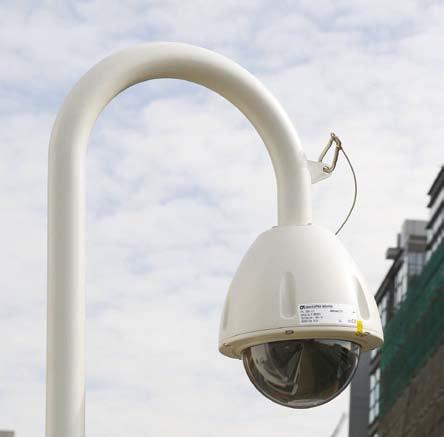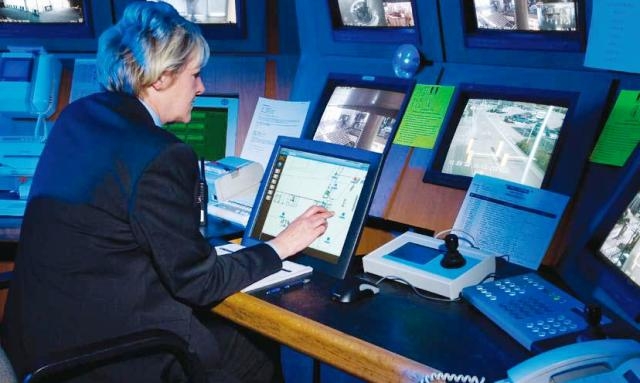Private CCTV systems outnumber government cameras 70 to 1
Research released last year by the British Security Industry Association has highlighted the use of CCTV surveillance in the UK, and has raised important questions about the need to regulate the CCTV sector. Amanda Caton, Head of Communications at the BSIA reports.
August 2013 saw the Home Office officially introduce its Surveillance Camera Code of Practice, which provides guidance on the appropriate and effective use of surveillance camera systems by Government-run authorities. Having played an active part in the development of the Code, the BSIA’s CCTV section has welcomed its launch, but recent research conducted by the Association has sparked calls for the Code to be extended to cover privately-owned systems too.
The BSIA’s research, released at a packed press conference in July 2013, represented the culmination of over two years’ work and has challenged the concept of ‘big brother’ style state surveillance, with new figures revealing that privately-owned CCTV systems outnumber those operated by police and local authorities by as many as 70 to 1.
Entitled The Picture Is Not Clear: How many CCTV surveillance cameras in the UK, the report reveals the truth behind the public perception of the UK’s ‘surveillance culture’, and the vast difference between public and privately-owned cameras highlights the fact that the government’s current regulation, whilst welcome, covers only a tiny proportion of CCTV systems, which already include the most professionally operated and tightly controlled government-run schemes.
 With the majority of cameras owned by the private sector, it is private companies who are actually funding the majority of the nation’s CCTV on the basis that it delivers a clear return on investment for their business, but it is from these privately-owned systems where the majority of footage used by Police is sourced.
With the majority of cameras owned by the private sector, it is private companies who are actually funding the majority of the nation’s CCTV on the basis that it delivers a clear return on investment for their business, but it is from these privately-owned systems where the majority of footage used by Police is sourced.
In fact, effective CCTV schemes are an invaluable source of crime detection and evidence for the Police. For example in 2009, 95% of Scotland Yard Murder cases used CCTV footage as evidence, and the technology has played a pivotal role in solving many high-profile cases including the Jamie Bulger case, the Tonbridge depot robbery and the 7/7 London bombings. The public are also largely supportive of CCTV, with 62% wanting to see more in their local area, and as such it is important that we, as an industry, retain their trust and confidence.
Pauline Norstrom, Vice Chair of the BSIA’s CCTV section, comments: "There is a popular misconception that the camera population in the UK is owned by the Government. The BSIA statistics set the record straight once and for all. It is private businesses who own the material camera population, not the Government. Day to day, these cameras are not available to the government and law enforcement agencies; they are busy working to protect their owner's premises.
“It is only when a major crime occurs that the Police ask business owners if they have captured any footage of criminals passing through the private cameras’ field of view. Without the help of businesses investing into their privately owned systems, the Police would only have access to the one publically owned camera per 1000 head of population. Far too few to be useful and certainly not the ‘surveillance society’ which is often portrayed in the media.”
Published following the implementation of the Protection of Freedoms Act (2012), the Surveillance Camera Code of Practice acknowledges the value of CCTV systems, stating that they “contribute to public safety and security and [protect] both people and property.”
Outlining the government’s intentions in releasing the Code, the Home Office states: “The purpose of the code will be to ensure that individuals and wider communities have confidence that surveillance cameras are deployed to protect and support them, rather than spy on them… Surveillance by consent should be regarded as analogous to policing by consent.”
The code, according to the Home Office, “should apply to all surveillance camera systems in public places,” and does go on to acknowledge that “many surveillance camera systems within public places are operated by the private sector, by the third sector or by other public authorities. Informed by advice from the Surveillance Camera Commissioner, the government will keep the code under review and may in due course consider adding others to the list of relevant authorities pursuant to section 33(5)(k) of the [Protection of Freedoms] 2012 Act.”
Indeed, the very definition of what constitutes a ‘public’ camera is also rather ambiguous, as the BSIA’s report highlights: “A definition of ‘public’ is difficult to determine. Whilst a camera mounted on a pole in the centre of a high street would probably be considered ‘public’, what would the opinion be of one mounted in an entrance corridor to a school? If a camera watching merchandise in a shop views only the interior of the shop, is this also a public area, and would that opinion be different if the view included the pavement outside the window?”
With so much riding on the integrity of privately-owned cameras, the extension of the Government’s Code of Practice to include these systems seems to be a logical next step, and would encourage the adoption of best practice among installers while driving standards of system selection, installation and operation. Regulation would also promote the importance of high quality systems with proper installation and setup.
Acknowledging the challenges of such a large piece of research, the report’s executive summary states: “Attempting to estimate the number of cameras has confirmed beliefs that producing an accurate estimate with available information is fraught with difficulties and any quoted figures, including those presented in this document, are open to challenge.”
 In a further development since the release of this research, the Home Office has appointed Antony Porter QPM LLB as the new Surveillance Camera Commissioner. After undergoing a stringent selection process, Mr. Porter’s three-year term will commence on 10th March 2014 when his predecessor, Andrew Rennison, completes his term of office.
In a further development since the release of this research, the Home Office has appointed Antony Porter QPM LLB as the new Surveillance Camera Commissioner. After undergoing a stringent selection process, Mr. Porter’s three-year term will commence on 10th March 2014 when his predecessor, Andrew Rennison, completes his term of office.
Currently serving as Vice President - Head of Physical Security Intelligence at Barclays Bank, Mr. Porter previously served in the police for 20 years, where he rose to the rank of Assistant Chief Constable within the Greater Manchester Police force, while serving as Deputy Senior National Coordinator for counter terrorism until October 2012.
As the trade body representing the UK’s private security industry, the BSIA – and particularly its CCTV section – has worked closely with the Surveillance Camera Commissioner’s Office over recent years and will look forward to working closely with the new Commissioner in the future.
The BSIA, as the leading organisation that represents the UK’s professional security industry, hopes that the debate opened up by this report, together with further studies, will increase the overall professionalism and quality of the CCTV industry and the systems installed.
For more information about the BSIA and its CCTV section, visit https://www.bsia.co.uk/cctv



